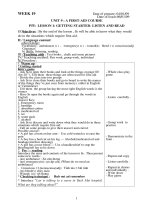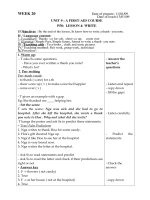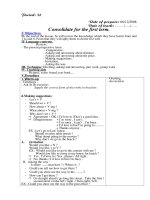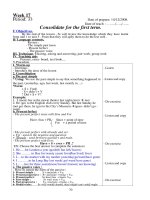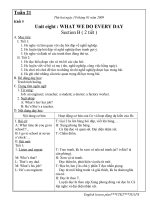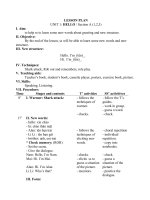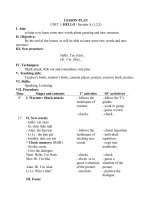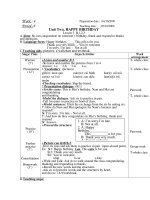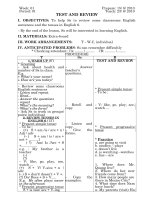- Trang chủ >>
- Đại cương >>
- Toán cao cấp
week 2
Bạn đang xem bản rút gọn của tài liệu. Xem và tải ngay bản đầy đủ của tài liệu tại đây (430.67 KB, 6 trang )
<span class='text_page_counter'>(1)</span><div class='page_container' data-page=1>
<b>I.</b> <b>Aims: To teach the structures:</b>
a) Good morning / afternoon………to greet each other.
b) We’ re …… to talk about us.
c) Numbers form 11 to 15
<b>II.</b> <b> Objectives: After finishing the lesson students will be able to greet each other </b>
each time on a day and cout numbers from 11 to15.
<b>III.</b> <b>Language content:</b>
Vocabulary:Good morning/ afternoon/ evening/ night/ bye, children, eleven,
<b> twelve, thirteen, fourteen, fifteen </b>
<i><b> Grammar: To be (present simple tense) with the first person (plural)</b></i>
<b>IV.</b> <b>Preparation : textbook, notebook, picture, cassette and tape</b>
<b>V.</b> <b>Procedures:</b>
<b>TIME</b> <b>CONTENT</b> <b>ACTIVITIES</b> <b>AIMS</b>
<b>1’</b>
<b>5’</b>
<b>9’</b>
<b>1O’</b>
<b>1. Class order:</b>
<b>2. Warm up: (Hangman)</b>
The word. eight
<b>3. New lesson:</b>
<b>Vocabulary :</b>
- Good morning Good night
- Good afternoon Goodbye = bye
- Good evening Children
- eleven = 11 fourteen = 14
- twelve = 12 fifteen = 15
- thirteen = 13
Checking memory:
<b>Presentation Dialogue ( B3 P 15 )</b>
MH: Good morning Children
C : Good morning, Miss Hoa
MH: How are you?
C : we’re fine, thank you. How are
you?
MH: Fine, thanks. Goodbye
b) Mom: Good night, Lan
Lan: Good night, Mom.
Greeting
- Draw 5 lines on the board ( each
line symbolizes a letter )
- Ask sts to think about some
words
- Ask sts to give letters ( one letter
at a time)
- Give the word if the sts don’t
guess 5 letters correctly and they
are losers
- Explain the uses of some
techniques to elicit new words
such as situations pictures.
- Say the words 3 times
- Ask sts to repeat ( chorall-
Individually)
- Write it on the board
- Check a stress
- Ss copy
- Uses the pictures to introduce
about greeting and saying
goodbye.
- Ask sts to listen and repeat.
- Check pronunciation and stress.
- Ask sts to look at the pictures
( P15 ) and identify the people in it
- Read first and tells sts to listen
- Read again 3 times and get sts to
repeat chorally
- Ask sts to practise in pair
- Revise and
introduce
new leson.
- Provide new
lesson.
- Check
memory.
- Ss practice
reading.
<b>Unit 1: GREETING</b>
<b>Lesson 3: B</b>
<i><b>1</b></i><i><b>-B</b></i>
<i><b>6</b></i><i><b> ( P.14-16)</b></i>
</div>
<span class='text_page_counter'>(2)</span><div class='page_container' data-page=2>
<b>11’</b>
<b>8’</b>
<b>1’</b>
Good morning Good night
Good afternoon bye
Good evening Goodbye
We' re…. = We are…
<b>Practice :</b>
<i><b> </b></i>
<i><b> Picture Drill</b><b> :( Numbers ) </b></i>
<b>Further Practice: </b>
<b>Ordering vocabulary: (16 </b>
numbers)
Six, twelve, two, five, thirteen, eight,
eleven, four, fourteen, seven, ten,
fifteen, one, three, oh, nine,
Anwers key:
Oh (15) one (13) two (3)
three (14)
Four (8) five ( 4) six (1)
seven (10)
Eight (6) nine (16) ten (11)
eleven (7)
Twelve (2) thirteen (5) fourteen (9)
fifteen (12)
4. Homework
- Learn by heart
- Prepare C1 - C4.
- Present the structures by asking
sts questions
- Give form, meaning and use
- Get sts to copy
- Call sts to say the difference
between each pictures.
- Run through vocabulary
- Hold the first picturen and model
- Ask sts to repeat chorally
- Do second picture as first one.
- Ask sts to say the sentence in
third picture until all finished.
- Stick the pictures on the board
( open pairs – close pairs.
- Move around and do the
correction
- Do as above
- Write 16 numbers on the board
- Ask sts to copy down
- Read them but not in a list on the
board
- Get sts to listen and number in
the correct order 1,2,3,…. Before
the numbers which they listen.
:
- Write the command on the board
- Get sts to copy down
- Ss practice
numbers
fluently.
- Practice
writing
</div>
<span class='text_page_counter'>(3)</span><div class='page_container' data-page=3>
<b>Week: 02Period: 04</b>
Preparing date:…….
Teaching date:…….
<b>I.</b>
<i><b>A</b></i>
<b>ims: </b>- To teach the structures “how old...?”.
- Numbers 16-20.
- How old are you? To talk about age and contrast with “ How are you ?”
<b>II.</b> <b>Objectives: - By the end of the lesson sts will be able to count numbers 16-20, introduce</b>
others and ask and answer about age.
<b>III.</b> <b>Language content:</b>
<i><b> Vocabulary: sixteen, seventeen, eighteen, nineteen, twenty</b></i>
<i><b> Grammar: To be (present simple tense) (Review)</b></i>
<b>IV.</b> <b>Preparation : textbook, notebook, picture, cassette and tape. </b>
<b>V.</b> <b>Procedures :</b>
<b>TIME</b> <b>CONTENT</b> <b>ACTIVITIES</b> <b>AIMS</b>
1’
5’
7’
6’
<b>1. Class order:</b>
<b>2. Warm up: (Jumbled words)</b>
<b>3. New lesson:</b>
<b>Vocabulary:</b>
sixteen : 16
seventeen : 17
eighteen : 18
nineteen : 19
twenty : 20
* Presentation diologue:
<b>Model sentences:</b>
Count from one to twenty with a
partner.
<b>How old are you ?:</b> Bạn bao nhiêu
tuổi.
I'm (<b>eleven</b>) : Tôi thì (11)
I'm eleven years old: Toâi 11
tuoåi.
S1: How old are you ?
S2: I'm ..
- Greeting.
- Review their old lesson by
playing a game: Jumbled
words.
- Correct and give their
marks.
- Elicit.
- Model.
- I - C repetition -
Correction.
- Record on the board.
- Check by playing a game
Pelmanism.
- Ask sts to read whole
numbers.
- Call sts to practise in
pairs.
- Elicit the new words and
sts give the E. words.
- Model.
- Call sts to repeat in C - G
- I.
- Notice the difference
between "How are you ?"
and "How old are you ?".
- Let sts practise the
conversation in their books.
- Model.
- Revise old lesson
and introduce new
lesson.
- Provide new
lesson.
- Provide new
structures
<b>Unit 1: GREETING</b>
<b>Lesson 4: C</b>
<b>1</b><b>- C</b>
<b>4</b></div>
<span class='text_page_counter'>(4)</span><div class='page_container' data-page=4>
12’
9’
1’
<i><b>Practice</b><b> :</b></i>
<b>Word cue drill:</b>
S1: How old are you ?
S2: I'm ...(thirteen, ten, fourteen, ...)
<b>Further practice:</b>
<b>Dictation: ( Telephone numbers)</b>
<b>4.Homework:</b>
- Learn by heart new words.
- Prepare new lesson.
- C - I repetition.
- Call sts to practise in close
and open pairs.
- Use the picture Drill to
check sts's memory.
- Check their memory by
drilling to ask and answer
about age.
- Read the numbers slowly
first
- Read again and gets sts to
copy down into their books.
- Read again for checking
- Ask sts to write
Telephone numbers on the
board.
- Write the command on the
board and asks sts to copy.
- Ss practice model
sententces fluently.
- Practice writing.
</div>
<span class='text_page_counter'>(5)</span><div class='page_container' data-page=5>
<b>Week: 02 Period: 05 </b>
Preparing date:…….
Teaching date:…….
<b>Unit 1: GREETING</b>
<b>Lesson 5: C</b>
<b>5</b><b>- C</b>
<b>6</b><b> p. (19)</b>
<b>I.</b> <b>Aims: To teach students to further practice in numbers 0-20 to count and give telephone </b>
numbers.
<b>II.</b> <b>Objectives: After finishing the lesson sts will be able to count and give telephone numbers </b>
more quickly and fluently.
<b>III.</b> <b>Language content:</b>
<i><b> Vocabulary:</b></i>
<i><b> Grammar:</b></i>
<b>IV.</b> <b>Preparation:</b>
<b>V.</b> <b>Procedures:</b>
<b>TIME</b> <b>CONTENT</b> <b>ACTIVITIES</b> <b>AIMS</b>
1’
5’
5’
5’
<b>1. Class order:</b>
<b>2. Further Practice</b>
<i><b>( Jumbled words) </b></i>
* Gessing game
Numbers: 0-20
Example : 5 Are you number 5?
Bingo: C5 p19.
Numbers 0-20
1 7 9
12 20 6
4 8 0
- Greeting.
- Write 6 words with Jumble
letters on the board and tell
the sts what the topic is
- Ask sts to write the words
correctly in their books
- Get sts to come to the board
and write the correct words
- Ask the sts to write down
one numbers from 0-20 into
piece of paper
- Get one sts to stand in front
of the class while other sts
ask yes, no question to guess
their friend’s number
- The student who guesses
correctly is the next one up.
( continues the game )
- Draw 9 squares on the board
- Ask sts to copy down and
fill any number in each
square ( Asks sts to choose 9
numbers and fill each number
into each square)
- Read the numbers 0-20 ( but
not in a list )
- Get sts to tick chosen
number when listening to the
teacher to read. The sts who
have 3 ticked numbers in any
- Revise old
lesson and
introduce new
lesson.
- play game to
revise numbers
from 0- 20.
</div>
<span class='text_page_counter'>(6)</span><div class='page_container' data-page=6>
15’
13’
1’
<b>* Dictation and picture:</b>
- Telephone numbers:
a.) 071 869737 b.) 05 40
839737
c.) 08 547 1316 d.) 04 821
4076
Example exchange:
S1: What’s your numbers?
S2: [ oh-five-one-one,
eight-two-six-six-nine-nine]
<b>Production (Survey)</b>
Name Telephone numbers
1. Hoa 033 612 300
2.
3.
4.
Ex: S1: What’s your name?
S2 : Hoa
S1: What’s your number?
S2: [ 033612300 ]
<b>3. Homework:</b>
- Learn your lesson.
- Prepare new lesson
line( across, down,
diagonally) Bingo
- Use the picture Drill to
count.
- Call sts to read and write.
- Say the telephone numbers.
- Call sts to write on the
board.
- Put a table on the board
- Ask sts to copy down and
tells sts what the topicis
- Ask sts to work in pairs to
ask and answer about names
and telephone numbers.
- Ask sts to fill in the
information when their
friends answer.
Get some sts to tell the
information after interviewing
- Write it on the board
- Ss copy down
- Ss practice
model sententces
fluently.
- Practice
writing.
</div>
<!--links-->
